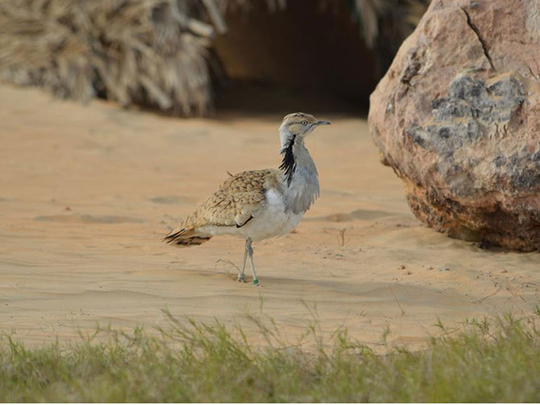
Abu Dhabi: Twenty Houbara Bustards (Chlamydotis undulata macqueenii) have been introduced to the Sir Bani Yas Island located in Abu Dhabi’s western region adding to its varied wildlife population.
The introduction of these endangered species at the award winning reserve is the result of joint efforts by the Department of Presidential Affairs, Sir Bani Yas Conservation Team and Barari Forest Management which manages the fauna and flora on the island on behalf of TDIC. Classified as vulnerable’ by the International Union for Conservation of Nature, IUCN, the birds have been currently placed near the Arabian Wildlife Park.
“We’re proud that Sir Bani Yas’ strong conservation record has set it apart as a place to implement successful wildlife initiatives, building on the vision of late Shaikh Zayed Bin Sultan Al Nahyan had for the island. We are also pleased to be a part of the efforts being undertaken to save the Houbara, which are an important bird species in the UAE. The flock will be strictly monitored and we hope the birds will begin to breed, which would be a great achievement for all involved in this important project,” said Marius Prinsloo, general manager of Sir Bani Yas Corporate Operations.
Houbara Bustards can be identified by their mottled brown top and white underside, with black stripes along their neck. The genders are similar, but the female is smaller and more grey. Houbara males have a flamboyant courtship display, whereby the male struts around in full display, with raised white feathers on the head and around the throat. This species is omnivorous, eating seeds, insects and other small creatures, having adapted to arid conditions with little vegetation. They can be found in stony and sandy desert and semi-desert regions ranging from Russia and the Middle East to areas in North Africa, as well as various Asian countries. They are widely prized as a quarry for falconers, and widespread hunting, poaching and loss of habitat have greatly reduced their numbers.
Malik Rapaie, Manager Wildlife and Conservation Services for Barari Forrest Management, said, “Releasing a species into the wild requires the involvement of multi-phased procedures and conditioning to train it to survive in such environments. To ensure they are successfully re-wilded, the birds have been placed in a well-designed area where they will be trained to acquire vital skills needed for their survival. Afterwards, the flock will be released into the Arabian Wildlife Park to establish their own breeding sites.
“Currently, the birds are being vigilantly monitored by wildlife biologists and veterinarians from the Barari Conservation Team to assess their adaptation to the island’s climate.”












